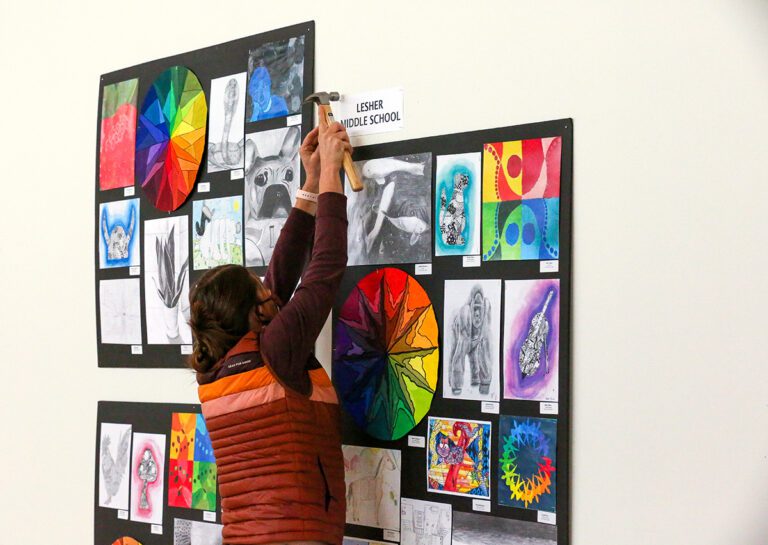The Art of Education University asked, and art teachers around the world delivered! In November, AOEU sent out the State of Art Education Survey and asked for input. In just a couple of weeks, the survey had over a thousand submissions! Art teachers are the best people to share the current trends, topics, and issues in the art room. AOEU uses the survey’s insight to help create relevant articles, videos, podcasts, lessons, courses, and more. All of this is to help art teachers everywhere be at the top of their art teacher game for their budding artists!
Let’s take a closer look at eight takeaways compiled from over 1,000 art teachers around the world.
Download the full report for more details!
Download Now!
Read the results from the past five years here:
1. Art programs are growing!
Give yourself a huge pat on the back because this is fabulous news! The number of full-time art teachers went up from 88% last year to 92% this year. Additionally, 3% more art teachers have their own classroom. The days of part-time art teachers on a cart are slowly disappearing. The bigger the art programs, the more students are impacted by the visual arts.

2. But there is still work to do.
As with anything, there is always room for growth! Fortunately, growth is a key part of the artistic process. 65% of art teachers are still the only art teacher in their building. While AOEU has a great online community, it’s not uncommon for art teachers to feel lonely. Let’s grow support for the field of art education so more students can have access to more art classes.
Here are three tangible areas we can advocate in:
- Fundraising
Although more than half of art teachers say their biggest challenge is a lack of funding and budget, almost half do not have time to fundraise or write grants. Fundraising is an excellent opportunity to partner with stakeholders to raise funds and awareness for your program and the arts. - Community Building
Stretch tight budgets with community donations and create valuable connections with community members. Utilize community figures, businesses, and organizations to enhance art shows, provide students with job or internship opportunities, or create an NAHS service project to beautify the community. - Cross-Curricular Collaborations
34% of art teachers said they never collaborate with other content areas or classroom teachers. Cross-curricular collaboration is a wonderful way to get to know colleagues better and spread the importance of the arts to students. Identifying and highlighting connections between the arts and other content areas solidifies and reinforces knowledge, as well as helps both elementary and secondary students see the bigger picture.

3. Choice-based teaching and the Studio Habits of Mind are popular teaching approaches.
Pretty much tied for first place as the most preferred teaching approaches are choice-based teaching and the Studio Habits of Mind. A bonus is that both of these approaches work well hand in hand!
Choice-based teaching and art are as simple as adding choices to your art classroom. Choice exists on a continuum, so there is no one way to implement choice. Choice allows students to have a say in their learning and work, thereby increasing buy-in and ownership. For more on choice, explore tips for elementary and secondary art rooms with our two Packs, Increasing Choice at the Elementary Level and Planning For Choice at the High School Level in PRO Learning, or enroll in Choice-Based Art Education.
The Studio Habits of Mind is a framework to help support the creative process and get students to think like artists. The eight habits, Develop Craft, Engage & Persist, Envision, Express, Observe, Reflect, Stretch & Explore, and Understand Art Worlds, are crucial skills that transcend the art room.

4. Art teachers are growing more confident with 3D art mediums.
Last year, 90% of art teachers said they were the most comfortable with two-dimensional mediums, such as painting and drawing, and they craved content about three-dimensional mediums, such as fibers. We heard your feedback and created more fibers content in 2022. We saw over 2,000 art teachers watched fibers-related PRO Packs, and over 100 art teachers completed the Studio: Fibers course.
And what do art teachers want to learn more about this year? The survey says art teachers want even more content on ceramics, digital art, and fibers.
To kick off ceramics learning, here are the top four Packs in PRO Learning to explore:
- Hand-Built Ceramics
- Basic Wheel Throwing
- Getting Started With Glazing
- Critical Kiln Safety

5. Most art teachers grade on a traditional letter or number system.
More than half (63%) of art teachers operate on a traditional letter or number grading system. Art teachers rely primarily on art projects, rubrics, and reflections to inform learning. While systems are great, learning cannot always be so easily quantified. Also worth noting is that grading and assessment are two different things, and sometimes they don’t align as smoothly as we’d like.
For ideas on how to refine or revamp grading and assessment systems, check out the four articles below:
- How to Take Letter Grades Out of Your Art Room to Refocus on Learning
- How to Motivate Your Students Beyond Grades
- How to Teach Self-Reflections, Critiques, Artist Statements, and Curatorial Rationales Like a Pro
- How to Streamline Your Summative Assessments with Our Awesome Plug n’ Play Rubric

6. Social media and technology are a growing presence in curriculums and studios.
More than half (55%) of art teachers use social media platforms as a curriculum resource, and the most used type of student technology is the laptop. Bringing the internet and similar technology into the studio can benefit learning. It can provide a glimpse into artists’ lives and studios around the world and throughout time. However, it can also take away from learning by affecting critical thinking and social skills.
Take a peek at some of AOEU’s resources on digital citizenship and managing technology to proactively meet student needs:
- How to Guide Students to Be Responsible Digital Citizens in the Art Room
- 13 Technology-Free Ways to Engage in the Art Room
- 12 Essential Understandings to Improve Your Art Students’ Research Habits
- 3 Subtly Effective Ways to Manage Screen Time in the Art Room
- Technology in the 21st-Century Art Room Graduate Course

7. District-level professional development leaves art teachers wanting more.
This one comes as no big surprise! Over half (52%) of art teachers say their district’s PD needs improvement because it’s not relevant or personalized. Fortunately, AOEU can provide relevant and personalized professional development. PRO Learning comes to the rescue by meeting 72% of art teachers’ preferences for short-form (3–10 minute) videos!
PRO Learning is the only on-demand professional development platform designed specifically for K–12 art teachers. Each Pack covers a specific topic in-depth and is further broken down into modules with short-form videos, guided reflective activities, and downloadable resources. If you are new to PRO, here are five ways it differs from your typical professional development. If you are interested in how your district can provide this for you, check out this article and fill out this quick contact form.
To see what a PRO video looks like, watch the sample below from the Introduction to Still Life Pack.
AOEU’s YouTube channel also has weekly releases of short-form videos. From mini-series on a specific topic or theme to glimpses into a Day of a Life of an Art Teacher, subscribe and turn your notifications on so you don’t miss out!
For the 73% of art teachers who like hands-on workshops, join Sarah Krajewski for an Instagram Live Make Art With Me each Monday evening. This is a fantastic way to network with the art teacher community in real-time while rejuvenating with artmaking facilitated by talented artists and art teacher guests.

8. Building relationships with students is what keeps art teachers going.
As cheesy as it sounds, it’s true—students keep art teachers going! After a few years of pandemic virtual teaching and learning, everyone craves face-to-face interaction. Goodbye to the days of black rectangles on a Zoom screen for high school teachers and herding cats for elementary teachers. Teachers missed building relationships with students in person, and now it’s everyone’s favorite thing!
If there is still a disconnect between you and your students, know you are not alone. Here are some tips to get those social skills back on track with fun games:
- 6 Exhilarating Classroom Management Games You’ll Want to Play in the Art Room
- Art Room Hacks: Quick Classroom Management Strategies (Ep. 6)
- Ideas for Art Room Games (Ep. 331)
- More Thoughts on Art Room Games (Ep. 337)

As an organization for art teachers, by art teachers, AOEU needs you! We appreciate the time art teachers spent taking this survey to share their input. It is thrilling that art programs are growing and art teachers are gaining confidence with three-dimensional art forms. Low budgets, fundraising, and irrelevant professional development are difficulties across the board. Art teachers are also navigating the growing social media and technology landscape. Let’s celebrate being fully back to face-to-face learning and all of the thriving relationship-building with students! Thank you, art teachers, for doing what you do best. We look forward to another year of serving art teachers and art students!
Which takeaway surprised you the most?
Which resources or offerings are you excited to look into?
Follow us on social media so you don’t miss anything!
Magazine articles and podcasts are opinions of professional education contributors and do not necessarily represent the position of the Art of Education University (AOEU) or its academic offerings. Contributors use terms in the way they are most often talked about in the scope of their educational experiences.






